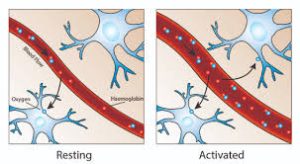 Blood-oxygenation-level–dependent imaging, or BOLD-contrast imaging, is a method used in functional magnetic resonance imaging (fMRI) to observe different areas of the brain or other organs.
Blood-oxygenation-level–dependent imaging, or BOLD-contrast imaging, is a method used in functional magnetic resonance imaging (fMRI) to observe different areas of the brain or other organs.
Neurons do not have internal reserves of energy in the form of sugar and oxygen.
Neuronal firing causes a need for more energy to be brought in quickly by a process called the hemodynamic response, as blood releases oxygen to active neurons at a greater rate than to inactive neurons.
This hemodynamic response causes a change of the relative levels of oxygenated or deoxygenated blood that can be detected on the basis of their differential magnetic susceptibility.
Hemoglobin has different magnetic properties in its oxygenated and deoxygenated forms both of which could be detected using MRI.
This magnetic signal variation which can be detected using an MRI scanner.
